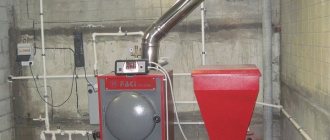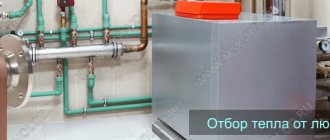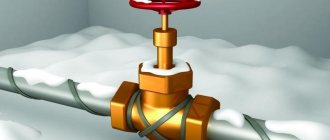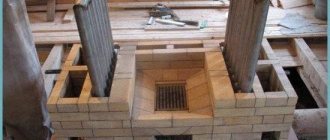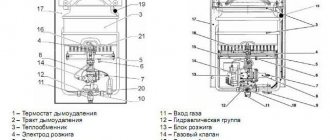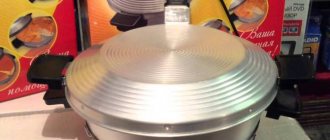Purpose of the boiler heat exchanger
A heat exchanger is a basic operational component of boiler equipment that transfers heat received as a result of the combustion of main gaseous fuel. It is located near the burner device.
The walls of the device are made of metal with a good heat transfer coefficient. The coolant liquid washes the heating surface of the heat exchanger, heats up to a temperature of 65-95 C and enters the intra-house heating network.
The movement of the coolant to the heating radiators occurs naturally, due to the temperature difference between the heated and cooled coolant, or in a forced way, using a centrifugal pump. Passing through the heating system, the cooled coolant returns to the boiler for the next heating cycle
In modern energy-efficient boilers, plate designs are the most common. In them, stainless steel plates are securely soldered to each other at the points of contact and along the edges.
This 100% guarantees tight operation, without leakage or mixing of liquids from different heating circuits.
The preferred material for soldering in such structures is copper. The design prevents scale formation and corrosion on the heating surface of the boiler. This ensures economical operation of the boiler unit with high efficiency.
Sale and installation of copper pipes
Request a call
Call around the clock, we work without holidays and weekends.
Our contact page
The emergency service operates around the clock in Moscow and the Moscow region. Departure to the nearest areas is planned according to the schedule.
| Name and technical characteristics | Qty | Unit. | Materials and equipment, ₽ |
| Copper pipe ⌀ 35 | 1,00 | m/linear | 1 408,80 ₽ |
| Copper pipe ⌀ 28 | 1,00 | m/linear | 634,80 ₽ |
| Copper pipe ⌀ 22 | 1,00 | m/linear | 570,80 ₽ |
| Copper pipe ⌀ 15 | 1,00 | m/linear | 348,56 ₽ |
| Copper angle 45° ⌀ 35 | 1,00 | PC. | 614,00 ₽ |
| Copper angle 45° ⌀ 28 | 1,00 | PC. | 112,00 ₽ |
| Copper angle 45° ⌀ 22 | 1,00 | PC. | 86,00 ₽ |
| Copper angle 45° ⌀ 15 | 1,00 | PC. | 62,10 ₽ |
| Copper angle 90° ⌀ 35 | 1,00 | PC. | 627,00 ₽ |
| Copper angle 90° ⌀ 28 | 1,00 | PC. | 112,00 ₽ |
| Copper angle 90° ⌀ 22 | 1,00 | PC. | 86,00 ₽ |
| Copper angle 90° ⌀ 15 | 1,00 | PC. | 62,10 ₽ |
| Copper tee ⌀ 35 | 1,00 | PC. | 680,00 ₽ |
| Copper tee ⌀ 35*28*35 | 1,00 | PC. | 714,00 ₽ |
| Copper tee ⌀ 35*22*35 | 1,00 | PC. | 714,00 ₽ |
| Copper tee ⌀ 35*15*35 | 1,00 | PC. | 714,00 ₽ |
| Copper tee ⌀ 28 | 1,00 | PC. | 156,00 ₽ |
| Copper tee ⌀ 28*22*28 | 1,00 | PC. | 156,00 ₽ |
| Copper tee ⌀ 28*15*28 | 1,00 | PC. | 156,00 ₽ |
| Copper tee ⌀ 22 | 1,00 | PC. | 127,50 ₽ |
| Copper tee ⌀ 22*15*22 | 1,00 | PC. | 127,50 ₽ |
| Copper tee ⌀ 15 | 1,00 | PC. | 82,00 ₽ |
| Copper coupling ⌀ 35 | 1,00 | PC. | 214,00 ₽ |
| Copper coupling ⌀ 35*28 | 1,00 | PC. | 317,00 ₽ |
| Copper coupling ⌀ 35*22 | 1,00 | PC. | 317,00 ₽ |
| Copper coupling ⌀ 35*15 | 1,00 | PC. | 317,00 ₽ |
| Copper coupling ⌀ 28 | 1,00 | PC. | 63,00 ₽ |
| Copper coupling ⌀ 28*22 | 1,00 | PC. | 63,00 ₽ |
| Copper coupling ⌀ 28*15 | 1,00 | PC. | 63,00 ₽ |
| Copper coupling ⌀ 22 | 1,00 | PC. | 56,00 ₽ |
| Copper coupling ⌀ 22*15 | 1,00 | PC. | 56,00 ₽ |
| Copper coupling ⌀ 15 | 1,00 | PC. | 34,00 ₽ |
| Brass end cap ⌀ 35*40 bunks | 1,00 | PC. | 1 420,00 ₽ |
| Brass end cap ⌀ 35*40 in. | 1,00 | PC. | 1 456,00 ₽ |
| Brass end cap ⌀ 35*32 bunks | 1,00 | PC. | 1 420,00 ₽ |
| Brass end cap ⌀ 35*32 bunks | 1,00 | PC. | 1 420,00 ₽ |
| Brass end cap ⌀ 35*32 int | 1,00 | PC. | 1 560,00 ₽ |
| Brass end cap ⌀ 28*25 Amer. | 1,00 | PC. | 720,00 ₽ |
| Brass end cap ⌀ 28*25 ext. | 1,00 | PC. | 720,00 ₽ |
| Brass end cap ⌀ 28*25 bunks | 1,00 | PC. | 530,00 ₽ |
| Brass end cap ⌀ 28*25 in. | 1,00 | PC. | 530,00 ₽ |
| Brass end cap ⌀ 22*20 Amer. | 1,00 | PC. | 620,00 ₽ |
| Brass end cap ⌀ 22*20 ext. | 1,00 | PC. | 620,00 ₽ |
| Brass end cap ⌀ 22*20 bunks | 1,00 | PC. | 530,00 ₽ |
| Brass end cap ⌀ 22*20 in. | 1,00 | PC. | 530,00 ₽ |
| Brass end cap ⌀ 15*15 Amer. | 1,00 | PC. | 396,00 ₽ |
| Brass end cap ⌀ 15*15 ext. | 1,00 | PC. | 396,00 ₽ |
| Brass end cap ⌀ 15*15 bunks | 1,00 | PC. | 130,00 ₽ |
| Brass end cap ⌀ 15*15 in. | 1,00 | PC. | 130,00 ₽ |
| Water socket ⌀ 15*15 in | 1,00 | PC. | 189,00 ₽ |
Types of heat exchangers
Today there are a number of alternative options for heat exchangers. They differ in their design and operating principle.
Based on the method of transferring heat obtained from the combustion of gas fuel, they are divided into 3 main modifications: primary, secondary and combined or bithermic.
Primary heat exchanger
The primary apparatus is made in the form of a copper tube, bent into a coil, on which many copper plates are located to increase the heat transfer area.
For the purpose of corrosion protection, the surface of the primary thermal apparatus is covered with a protective layer. The size of the pipes and the number of fins determine the power of the device.
In terms of design, all primary heat exchangers are identical, but differ in thermal power, geometric dimensions and tube connection diagram.
The heat transfer process in such structures is affected by contamination of the plates with soot, as well as the thickness of scale on the inner heating surface.
Such deposits significantly reduce heat transfer from hot gases to the coolant, thereby causing zonal overheating of the metal and possible rupture of the structure with hot water escaping outside.
Secondary heat exchanger for gas boiler
A modification of boiler heating devices is called a DHW heat exchanger. As a rule, it is made in a rectangular shape and consists of a set of stainless steel plates of complex configuration.
The greater their number, the higher the power of the device. There can be from 10 to 30 layers. Each layer is isolated within the boundaries of one heat exchange structure.
When the plates are placed on top of each other, a circulation channel for the coolant is created. The thickness of the partitions is usually 1 mm. The high thermal conductivity of the metal and the developed heating surface provide the calculated heat transfer and the speed of movement of the coolant.
When you open the DHW shut-off valve on a home mixer, the boiler three-way valve orients the direction of movement of hot water in the second circuit.
Then the hot medium in the secondary device gives off heat to water from the cold water network, while it cools down and moves into the return pipeline, where it mixes with water from the heating network and enters the primary heat exchanger on the gas boiler.
Bithermic device
The bithermic heat exchanger has two circuits in its design: heating and hot water. Structurally, the bithermal device is made of the coaxial “pipe-in-pipe” type; the inner surface is finned with soldered copper plates. The inner tube of the device is intended for heating hot water, and the outer tube is for heating circuit water.
This design of the heat exchanger eliminates the need for additional components: a three-way valve and a secondary heating apparatus, which leads to a significant reduction in the cost of the boiler unit and increases the level of safe operation.
The disadvantage of this design is that heat transfer in DHW mode limits the heat supply to the heating circuit.
If the DHW water intake continues for a long time, the temperature of the internal air in the house may decrease, and the air regime will not correspond to the sanitary standard in the room. In addition, such devices cannot be used in areas where the feed water for boilers is hard, which can clog the boiler heating surfaces with scale.
Which material is better
Boiler heat exchangers are made of different metals, the selection of which is made by the manufacturer during the design of the heating source.
Basically, modern devices are equipped with heat exchangers made of steel, cast iron, copper and aluminum. They have different heat transfer coefficients, permissible temperature environments and resistance to corrosion processes. A floor-standing gas boiler with a cast iron heat exchanger is the most economical and durable.
Steel
A stainless steel heating apparatus is technologically the simplest, both in manufacture and in operation. Therefore, it has the most affordable price, which affects the overall cost of the boiler.
Steel has good ductility, so this design in an environment of high-temperature hot gases is less susceptible to temperature deformation.
But at the same time, steel is affected by corrosion, both internally due to dissolved oxygen in the coolant, and externally due to acidic moisture in the flue gases, especially at the time of starting from a cold state. Therefore, these heat exchangers are not durable, have a lot of weight and create low boiler efficiency.
Aluminum
Many Western models are equipped with aluminum heat exchangers, to which experts attribute a great future in household heat and power engineering.
With high ductility, they have thermal conductivity 9 times higher than that of steel. In addition, they have high functionality with low weight.
In such structures, stress zones are not created during a welded joint, like stainless steel devices, and, therefore, there will be no corrosive hazardous areas.
Aluminum components are characterized by strong chemical resistance, which is used in low temperature applications or condensing type boilers.
However, aluminum structures will last less if they use hard tap water; they become clogged with scale almost immediately.
Therefore, initially, manufacturers of boilers with aluminum heating surfaces recommend that owners install water treatment with a water softening system.
Copper
Copper surfaces in boiler heat exchange devices are compact and lightweight, so they are installed on a Navien gas boiler.
Copper is essentially non-corrosive in aggressive acidic environments. Boiler units with similar devices are compact and easy to use. Due to their low inertia, copper devices quickly heat up and cool down.
Copper heat exchangers have more advantages than negative qualities. The copper structure is lightweight, compact, and has a small capacity.
It is not afraid of corrosion processes and requires less gas consumption to heat the coolant. Disadvantages include high cost and unreliability under non-standard cold start-up conditions.
Gas boilers with cast iron heat exchanger
A cast iron boiler heat exchanger is considered the most efficient and durable because it is not subject to corrosion. Moreover, since the material is very fragile, it requires proper use.
Uneven heating of the structure, which occurs at the time of start-up from a cold state or in places of scale formation, leads to the appearance of various cracks in the walls of the structure.
Users of such a device will need to monitor the quality of the feed water, install a cleaning system, and if scale appears for gas boilers with a cast iron heat exchanger, flush the heat exchanger.
Usually it is performed once a year before the start of the heating season. If the feed water is pre-cleaned before being supplied to the boiler, then the flushing frequency is once every 4 years.
Malfunctions and repair work
The operation of a unit with two heat exchangers depends on the metal: steel or cast iron, and can last from 8 to 15 years, respectively, if the user performs all routine maintenance established by the boiler equipment manufacturer.
The most common failures of a heat exchanger are scale and ruptures of heating surfaces due to burnout of the heat exchanger wall or high pressure/temperature parameters of the coolant.
If the owner of the unit can cope with the first problem himself and repair the heat exchanger of a gas boiler with his own hands, then a rupture of the device practically cannot be repaired, but must be completely replaced with a similar design. Specialists can solder the heat exchanger for gas boilers, but, as a rule, after such repairs it is not durable.
Replacing a defective heat exchanger
Replacing a Western-assembled heat exchanger that is under warranty is carried out by a service center, while domestic models can be replaced independently.
To do this, first select the desired modification; if it is not available in the retail chain, contact the manufacturer. In order to replace a faulty boiler element, you will need to remove the defective device.
Algorithm for dismantling the boiler heat exchanger for replacement or descaling:
- Disconnect the boiler unit from the gas mains and the electrical network.
- Remove the front panel.
- I close the fittings on the coolant supply and return pipes.
- Open the drain valve and drain water from the network and boiler.
- Remove the fastening on the gas pipe and disconnect the gas pipe.
- Remove the cover of the automation system from the primary devices.
- Dismantle the sensors from the combustion chamber, remove the fastenings on the lid and remove it.
- Turn off and dismantle the fan in order to remove the heat exchanger.
- Remove the clamps on the pipes connected to the primary heat exchanger.
- Remove the furnace of the boiler unit and move it indoors.
- Remove the top cover of the compartment.
- The primary apparatus is removed.
- Install a new heat exchanger on the gas boiler and reassemble the boiler in the reverse order.
Contact us!
We are a service center specializing in the repair of plate heat exchangers of all brands. We have a staff of highly qualified employees, therefore we are able to guarantee excellent quality of service. We are able to carry out any repair work on heat exchangers:
- complete and thorough diagnostics of the device;
- restoration of tightness;
- eliminating leaks between the honeycombs and sealing the outer one;
- flushing the coolant;
- and much more.
high-quality heat exchanger repairs with competent advice - we explain in detail how the further operation of the repaired device should proceed. In this way, we help the client avoid subsequent problems with gas heating equipment.
It is also beneficial to use the services of our service center in terms of cost - you will have to carefully search for lower prices than ours. In most other services, repairing exchangers will cost you much more.

